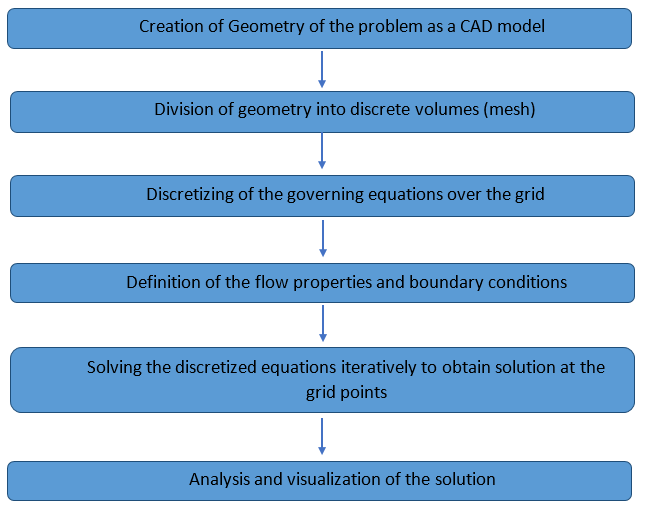AcuSolve Workflow Introduction
This section gives a brief description of a general workflow of a typical CFD process. It describes in short the problem description, pre-processing, solving and post-processing aspects of a CFD workflow.

Figure 1. Basic Workflow
AcuSolve is a robust software that does all of the above steps of CFD and provides the accurate solution to the problem.
General Workflow
- Problem Description
- Though often neglected, this step is the foremost important aspect of a successful
CFD simulation. Before attempting a CFD simulation a clear description of the problem
is necessary. This step involves the following tasks.
- Identify the domain of interest: Though in principle domain of any size can be analysed with CFD simulation, it is often wise to choose the critical regions in which flow field is of importance and simulate the flow in that domain. Minimizing the size of the domain keeps the simulation costs low, but comes at the expense of introducing non physical behavior in the simulation by having boundaries too close to regions in the flow where the results are of interest. It is important to select boundaries where the flow character is known so that proper boundary conditions can be applied.
- Identify the nature of the flow: It is always helpful to make an educated guess on the nature of the flow, such as whether it is steady/transient, laminar/turbulent, thermal/non thermal. For example, while analysing a flow in a pipe that has low Reynolds number, say Re ~ 100, it is useful to perform a laminar analysis rather than doing an expensive turbulent flow analysis with a larger mesh count.
- Pre-Processing
- This process involves geometry import, mesh generation and specifying the relevant physics equations to be solved. Pre-processing also involves defining the fluid properties, boundary conditions and body force parameters. AcuSolve uses AcuConsole for the pre-processing of the geometry and AcuMeshSim, which is launched from AcuConsole itself, for the mesh generation.
- Solving
- Solving is the critical part of a CFD simulation. The governing flow equations are discretized. All these algebraic equations are then solved for the unknown flow parameters. The final solution is the quantitative representation of these parameters at the mesh generated nodes. As a first step of solving, the AcuPrep module of AcuSolve checks for the compatibility of the information provided in the pre-processing step. The source of errors in AcuPrep could be because of insufficient inputs, syntax errors, and so on. After AcuPrep the actual solving of equations is performed.
- Post-Processing
- Having solved for the unknowns, the next step is the analysis of this huge data to obtain relevant insight. This data can be analysed either in the form of contour plots or tabular data to identify the critical portions of the flow field. AcuSolve is integrated with the post-processing tools like AcuTrans, AcuProbe and AcuFieldView which provide various options of post-processing.